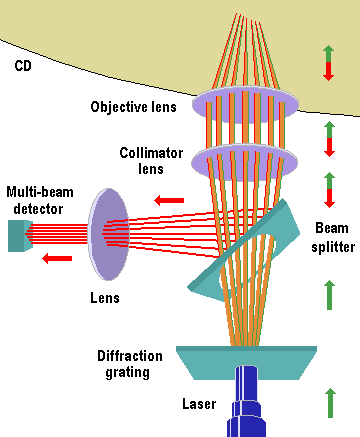Based on the aim of enabling users to run application direct from CD without first cacheing to the hard disk drive, Zen Research’s TrueX technology takes a different route to increasing the performance of CD-ROM drives – addressing data transfer rates and access times rather than simply seeking to spin discs faster. Unlike the conventional CD-ROM, which uses a highly concentrated laser beam to read the digital signal that’s encoded as tracks of small pits on the surface of a disc, the Zen approach uses a custom ASIC to illuminate multiple tracks, detect them simultaneously and read them in parallel. The ASIC integrates analogue interface elements like digital phase-locked loop (DPLL), DSP, servo-motor controller, parallel to serial data converter, data decoding and error detection/correction and ATAPI interface. Provisions have been made to allow the connection of an external SCSI or IEEE 1394 interface chip if required.

A diffracted laser beam used in conjunction with a multiple beam detector array illuminates and detects multiple tracks. A conventional laser diode is sent through a diffraction grating that splits the beam into seven discrete beams, spaced evenly to illuminate seven tracks. The seven beams pass through the beam splitting mirror to the objective lens and onto the surface of the disc. Focus and tracking are attained with the central beam. Three beams on either side of the centre are readable by a detector array as long as the centre is on track and in focus. The reflected beams return via the same path and are directed to the detector array by the beam splitter mirror. Seven detectors are contained in the multi-beam detector to align with the reflected tracks. Conventional detectors are also provided for focus and tracking.
Although the mechanical elements of the CD-ROM drive are slightly changed – disc rotation and read head motion remain the same – the format of the disc media remains CD or DVD standard and the design uses a conventional approach to tracking and seeks. Although TrueX can be applied to both CLV and CAV disc rotation systems, Zen has focused on CLV in order to deliver constant transfer rates across the whole disc. In either case, higher data rates are achieved at lower, more disc-tolerant rotation speeds, reducing vibration and promoting smoother operation and greater reliability.
Kenwood Technologies shipped its first TrueX CD-ROM drive – a 40-speed device – in August 1998 and followed this up six months later by unveiling a 52-speed device. A typical CD is less than half full, and the majority of all CDs contain no data on their outer tracks. Depending upon the operating environment and quality of media, the Kenwood 52X TrueX CD-ROM drive delivers a typical performance ranging from 6750 – 7800 KBps (45X to 52X) across the entire disc. By comparison, a conventional 48X max CD-ROM drive performs at 19X on its innermost tracks, but achieves 48X performance only on the disc’s outermost tracks (if the disc is full) – and at rotational speeds more than double that of the Kenwood device!
- CD-ROM Red Book
- CD-ROM Yellow Book
- CD-ROM XA
- CD-ROM Green Book
- CD-ROM Orange Book
- CD-ROM White Book
- CD-ROM Blue Book
- CD-ROM Purple Book
- CD-ROM CD-I Bridge
- CD-ROM Photo CD
- CD-ROM File Systems
- CD-ROM Manufacturing
- CD-ROM The Disc
- CD-ROM Operations
- CD-ROM Digital Audio
- CD-ROM CLV
- CD-ROM CAV
- CD-ROM Applications
- CD-ROM Interfaces
- CD-ROM DMA vs. PIO Mode
- CD-ROM TrueX Technology